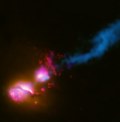
Have you ever come across this kind of description of an astronomical event:
“…astronomers have witnessed a supermassive black hole blasting its galactic neighbor with a deadly beam of energy…Both galaxies are situated about 1.4 billion light-years away from Earth…The offending galaxy probably began assaulting its companion about 1 million years ago…”
How can that be? asks Sciencebase reader Adam Azman. If the event is at a distance of 1.4 billion light years from Earth it will have had to have started its journey from that point in space to reach us 1.4 billion years ago, yet, the article tells us the event only began 1 million years ago? It seems quite paradoxical, but according to Dave Mosher, author of the article Galaxy Blasts Neighbor with Deadly Jet, the explanation is quite simple and essentially glosses over Einstein’s theory of relativity to help astronomers talk about the times and distances as if there were a fixed universal frame of reference.
“Most astronomers,” Mosher told Sciencebase, “refer to time relative to Earth when they say something happened. E.g. as an observer on Earth 1 million years ago, the event would have just been getting started. They avoid stating it happened 1.401 billion years ago because of the quirkiness of relativity…in other words, just because light appears to be 1.401 billion years old doesn’t mean it actually is… there’s too much fudge factor to be certain. It’s more accurate AND precise to say the light reached Earth 1 million years ago.” He admits that the issue sometimes “fries his brain”, and told Sciencebase that he is “really going to start putting an explanatory graph in my stories from now on… there’s no way around it.”
Meanwhile, Azman, a chemistry student at the University of North Carolina Chapel Hill, had also done some digging of his own and had spoken to Bryan Preston, a political blogger who often writes about cosmological matters. Preston’s explanation is close to that of Mosher, “The ‘million years ago’ bit is a reference to ‘as seen from earth’ – if we’d had a Hubble telescope a million years ago, we could have seen this event begin,” he says, “But the event actually happened 1.4 billion years ago and it took the light that long to get to us to see it in the first place.”
Preston adds that, “if we’d been technologically advanced a million years ago, we’d have used that technology to see the start of the Death Star’s bombardment of its neighbor. To have seen it all happening when it actually happened, we’d have had to be at the scene, 1.4 billion light years away from Earth.”
These timelines can be confusing and are a constant source of letters to the editor for popular science publications and space websites. “For instance,” adds Preston, “we name supernovae by the year they were observed to have blown up, hence SN1987A. But that star was 100,000 light years away, so it actually blew up 100,000 years ago, but we just saw it blow up in 1987 because it took the light 100,000 years to get here.”
It’s all relative, you see?

